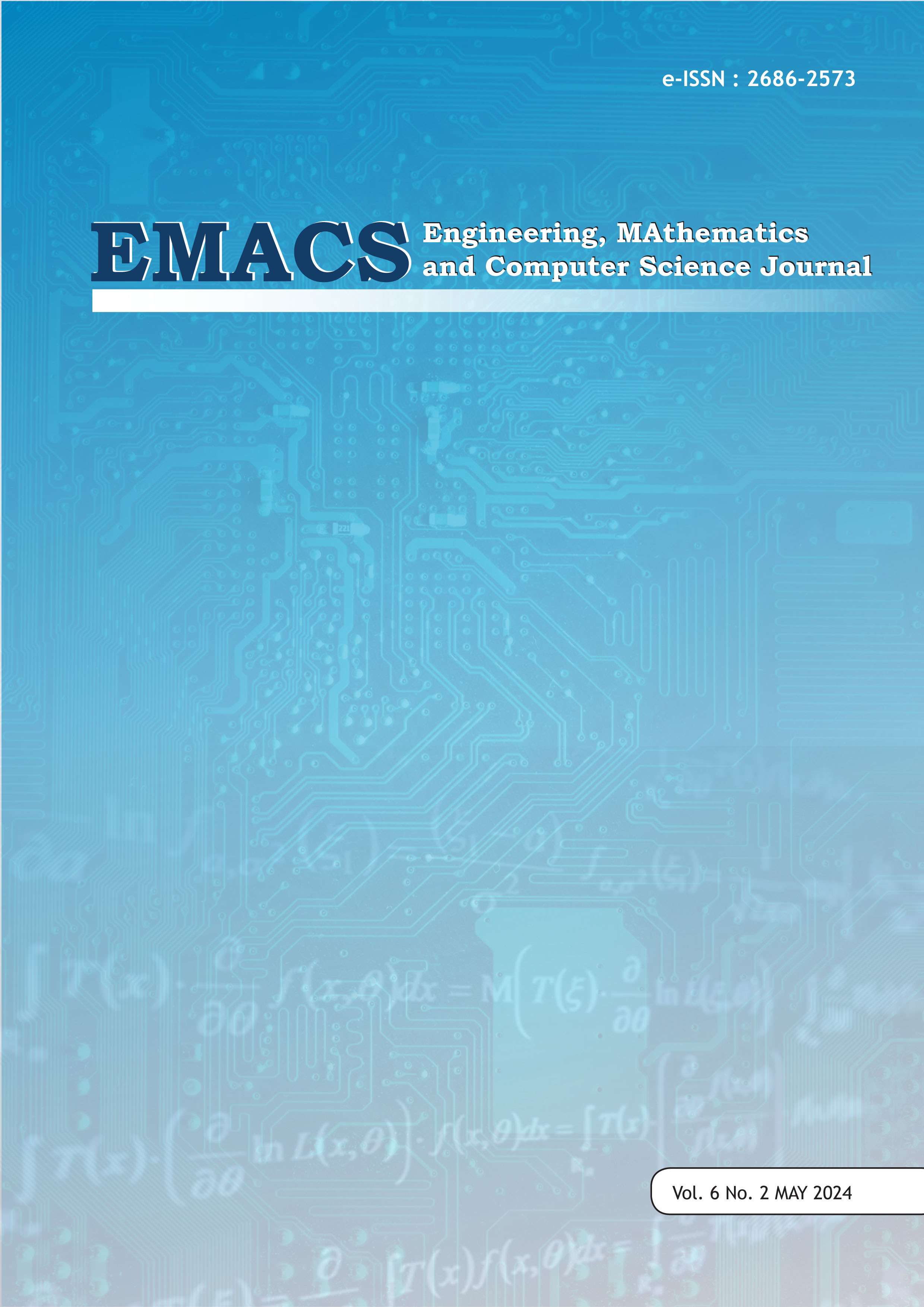Relationship Between Temperature and Humidity on Rainfall
A Multiple Linear Regression Analysis
DOI:
https://doi.org/10.21512/emacsjournal.v6i2.11466Keywords:
Rainfall, Multiple Linear Regression, RelationshipAbstract
Indonesia is one of the tropical countries in the world that has two seasons, the dry season and the rainy season. One of the biggest challenges in tropical countries is flooding caused by heavy rainfall. Not only does it cause flooding, rainfall also affects several sectors especially agriculture. Areas that have a lot of rain-fed agricultural land, especially rice fields, depend on rainfall because it determines crop yields. This study uses data from 12 sub-districts in Mojokerto district where agricultural activities are one of the pillars of the economy in the region. There are various factors associated with rainfall such as temperature and humidity. The data used is the year 2022 using multiple linear regression. Based on the results of the study, both predictor variables have a strong and positive relationship with rainfall with a correlation coefficient of 0.760007. With a significance level of 5% or 0.05, in the partial test, only the humidity variable has a significant effect on the amount of rainfall. While in the simultaneous test, both variables have a significant effect. These factors together have a coefficient of determination of 0.57761 or the contribution of the influence of the two predictor variables of 57.761% while the remaining 42.239% by other variables.
References
Ghozali, I. (2018). Aplikasi Analisis Multivariate dengan Program IBM SPSS 25. Semarang: Badan Penerbit Universitas Diponegoro.
Hidayatullah, M. L., & Aulia, B. U. (2020). Identifikasi dampak perubahan iklim terhadap pertanian tanaman padi di Kabupaten Jember. Jurnal Teknik ITS, 8(2), 143-148.
Luthfiarta, A., Febriyanto, A., Lestiawan, H., & Wicaksono, W. (2020). Analisa Prakiraan Cuaca dengan Parameter Suhu, Kelembaban, Tekanan Udara, dan Kecepatan Angin Menggunakan Regresi Linear Berganda. JOINS, 5(1), 10–17.
Mardiatmoko, G. (2020). Pentingnya uji asumsi klasik pada analisis regresi linier berganda (studi kasus penyusunan persamaan allometrik kenari muda [canarium indicum l.]). BAREKENG: Jurnal Ilmu Matematika Dan Terapan, 14(3), 333-342.
Maulina, V., Harun, L., & Sutrisno, S. (2022). Pengaruh Minat Belajar dan Resiliensi Matematis Terhadap Kemampuan Pemecahan Masalah Matematis Siswa. Imajiner: Jurnal Matematika Dan Pendidikan Matematika, 4(4), pp. 347-354.
Nurhayati, E., Rizaldi, D. R., & Fatimah, Z. (2020). Pencegahan Penyebaran Covid-19 Melalui Inaktivasi Virus dalam Kajian Kinetika, Termodinamika dan Kesetimbangan. Jurnal Ilmiah Profesi Pendidikan, 5(2), 102-107.
Putra, R. M. (2023). Prediksi Kelembaan Udara di Provinsi Jawa Timur Menggunakan Metode Regresi Linear Sederhana (Masters’s thesis), Available from E-Learning
Universitas Islam Lamongan. (Unisla No. 2184)
Quraisy, A. (2020). Normalitas data menggunakan uji kolmogorov-smirnov dan saphiro-wilk: studi kasus penghasilan orang tua mahasiswa prodi pendidikan matematika unismuh makassar. J-HEST Journal of Health Education Economics Science and Technology, 3(1), 7-11.
Rath, S., Tripathy, A., & Tripathy, A. R. (2020). Prediction of new active cases of coronavirus disease (COVID-19) pandemic using multiple linear regression model. Diabetes & metabolic syndrome: clinical research & reviews, 14(5), 1467-1474.
Sari, M., & Fitriyani, S. (2021). Analisis Spasial Temporal Sosiodemografi Dan Variabilitas Iklim Terhadap Kejadian Tuberkulosis Paru BTA Positif di Provinsi Jawa Barat Tahun 2013-2017. Jurnal Untuk Masyarakat Sehat (JUKMAS), 5(2), 140-150.
Sam, M., Pamungkas, I., & Muzaini, M. (2021). Pengaruh Banyaknya Perusahaan Industri, Jumlah Tenaga Kerja, Jumlah Produksi Galian/Pertambangan Serta Luas Area Perkebunan dan Perikanan Terhadap PDRB Provinsi Sulawesi Selatan. Infinity: Jurnal Matematika dan Aplikasinya, 2(1), 72-83.
Sofro, A., Oktaviarina, A., & Maulana, D. A. (2019). Uji Hipotesis, Uji Z dan Uji T. Metode Statistika (pp. 35-54). Surabaya, Indonesia: Unesa Press.
Umami, A., & Sutikno, S. (2020). Perbandingan Estimasi Return Level Declustering dan Non Declustering pada Data Curah Hujan Ekstrem di Surabaya dan Mojokerto. Jurnal Sains dan Seni ITS, 8(2), 79-87.
Wisudaningsi, B. A., Arofah, I., & Belang, K. A. (2019). Pengaruh kualitas pelayanan dan kualitas produk terhadap kepuasan konsumen dengan menggunakan metode analisis regresi linear berganda. Statmat: Jurnal Statistika Dan Matematika, 1(1), 103-116.
Yaldi, E., Pasaribu, J. P. K., Suratno, E., Kadar, M., Gunardi, G., Naibaho, R., & Aryati, V. A. (2022). Penerapan uji multikolinieritas dalam penelitian manajemen sumber daya manusia. Jurnal Ilmiah Manajemen dan Kewirausahaan (JUMANAGE), 1(2), 94-102.
Downloads
Published
How to Cite
Issue
Section
License
Copyright (c) 2024 Mohammad Dian Purnama, Mutia Eva Mustafidah

This work is licensed under a Creative Commons Attribution-ShareAlike 4.0 International License.
Authors who publish with this journal agree to the following terms:
- Authors retain copyright and grant the journal right of first publication with the work simultaneously licensed under a Creative Commons Attribution License - Share Alike that allows others to share the work with an acknowledgment of the work's authorship and initial publication in this journal.
- Authors are able to enter into separate, additional contractual arrangements for the non-exclusive distribution of the journal's published version of the work (e.g., post it to an institutional repository or publish it in a book), with an acknowledgment of its initial publication in this journal.
- Authors are permitted and encouraged to post their work online (e.g., in institutional repositories or on their website) prior to and during the submission process, as it can lead to productive exchanges, as well as earlier and greater citation of published work.
USER RIGHTS
All articles published Open Access will be immediately and permanently free for everyone to read and download. We are continuously working with our author communities to select the best choice of license options, currently being defined for this journal as follows: Creative Commons Attribution-Share Alike (CC BY-SA)





